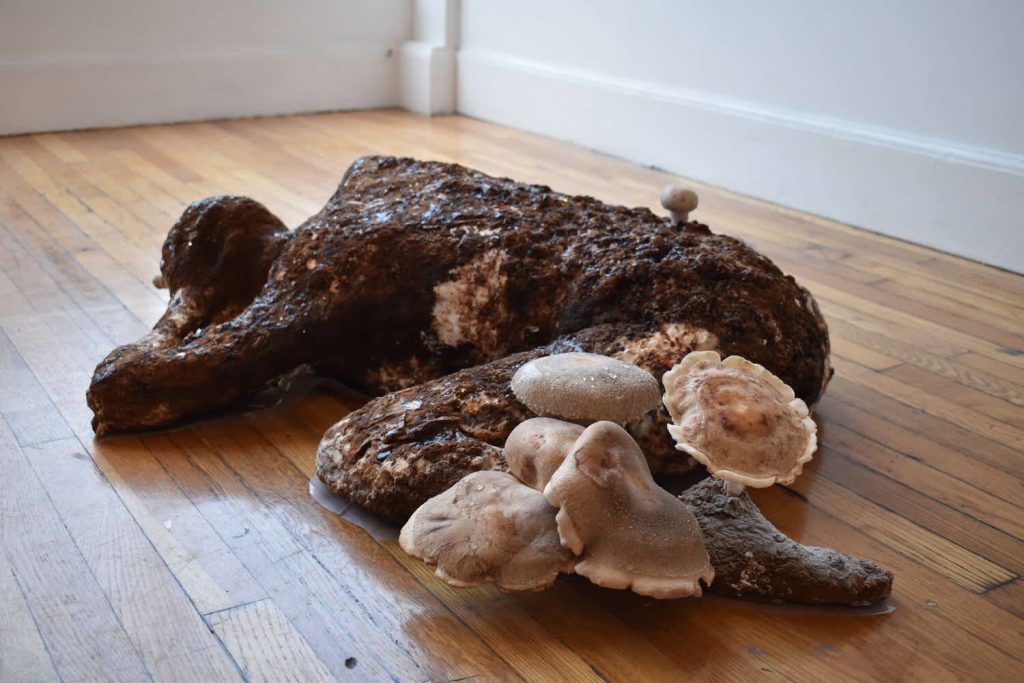Mushrooms are not the obvious go-to medium for an artist. While they might be beautiful, they’re also fragile and tend not to last too long. Having said that, you might be surprised to learn that mushrooms have a long and intricate connection with art and artists – and not just for their sometimes mind-altering abilities.
Ink Caps (Coprinopsis atramentaria) have been used, as their name might suggest, to make ink, which you can do yourself with relative ease. Another mushroom, Ganoderma applanatum, grows in wide sheets from the trunks of trees and is known as the Artist’s Conk for its flat, etch-able surfaces that hold images permanently when dried.
But making art from mushrooms themselves is relatively unheard of. Enter Californian artist Serena JV Elston. In a recent show called Fruitful Bodies, she sculpted human forms from plaster and mushroom substrate, inoculating the pieces with all kinds of beautiful, edible mushrooms.
The results are pretty wild. We caught up with her below to find out more about the project.
Fruitful Bodies is an exploration of violence against women that draws on Greek mythological themes to illustrate a loss of agency for both the female body and the natural world.
“Mushrooms were chosen because of their magical, mysterious quality. They exist all around us, yet dwell hidden in the soil,” Elston told TheLatch via email. Using her own body as the cast for these moulds, Elston tells us the process was a difficult one, though “sipping whiskey helps a little but then you have to pee”.
Her work is inspired by Madeline Miller’s book Circe. “Her story gives language and depth to nymphs – female spirits of nature – who historically are objects acted upon in mythology,” Elston said.
“Her book details the horrific and all too common act of sexual assault against nymphs and allows it to take the space it demands. Miller doesn’t skip over or try to hide this fact with worlds like ‘seduced’, a common troupe in The Classics. After reading Circe, I wanted to further this anti-misogynistic retelling using sculpture.”
Elston pairs different mushroom species with certain properties with different types of nymphs. You can see figures without heads or hands crawling towards the windows and doors in failed attempts to escape the gallery.
“They materially show the metamorphosis or transmogrification of these nymphs when they are attacked,” Elston explained.
“I wanted the viewers to recognise the edible mushrooms and know they had partaken in the consumption of these once magical creatures. But also, the cycle of feminine sacrifice is what allows humans to thrive on earth,” Elston said.
“I explore this idea more in my piece Horn of Plenty. When women create life, they are simply mothers. When men create life, they are called gods”.
The beautiful but horrifying works offer an allegory for Western civilisation’s cultural domination over nature and the commodification of women’s bodies.
“Mushrooms are a powerful and untamed element of nature,” Elston says. “I hope that mushrooms, by the virtue of this work, can help us heal our collective consciousness from the disease of misogyny.”
Elston will be the Artist in Residence at Tiger Strikes Astroids in Los Angeles through March 2021, exploring the role of hunger as an allegory for the economy.
You can find more of her work at www.serenajve.com or follow her on Instagram.
Read more stories from The Latch and follow us on Facebook.

